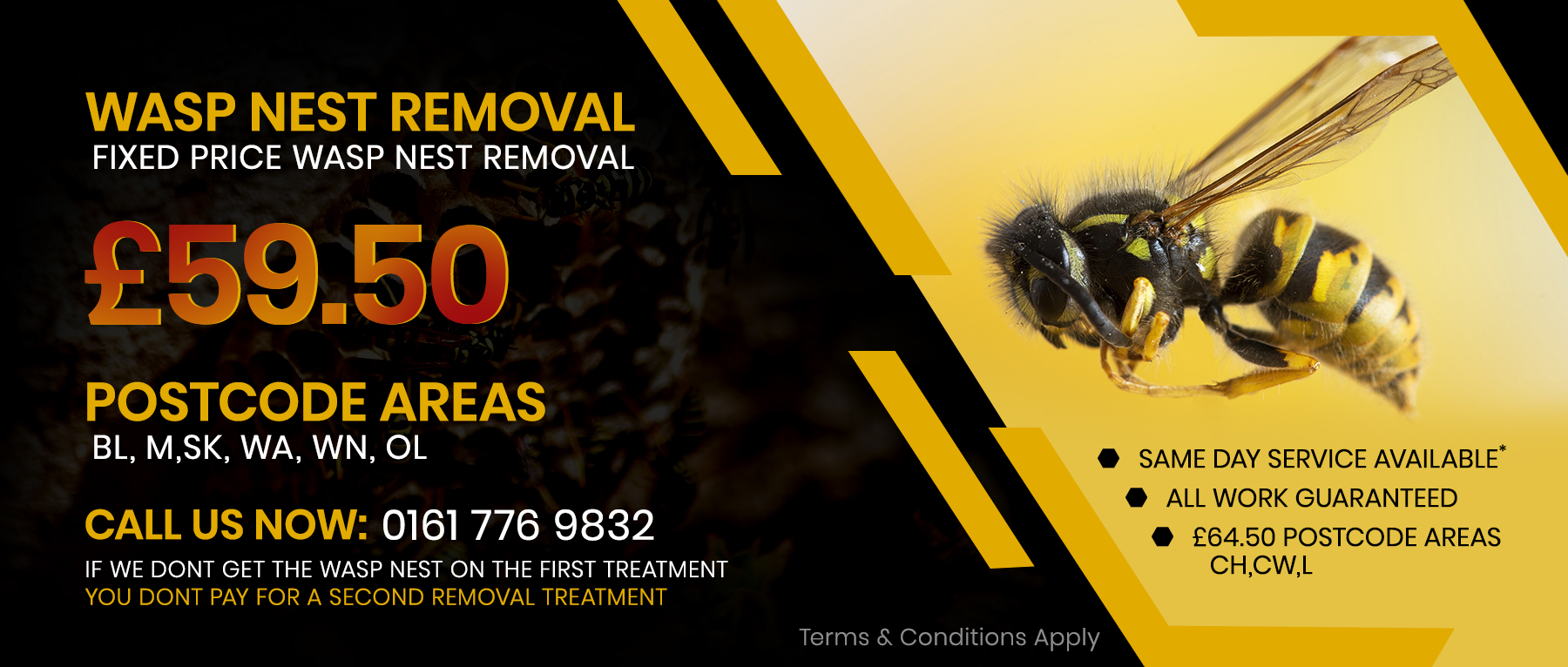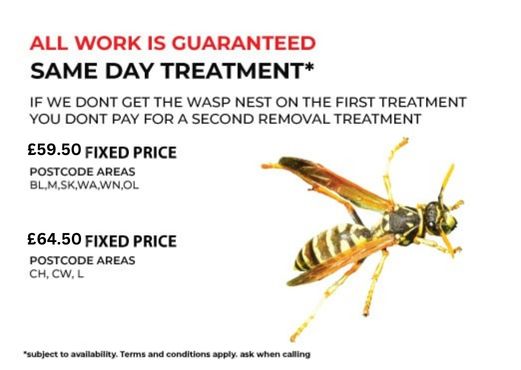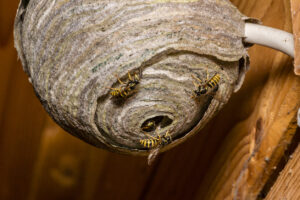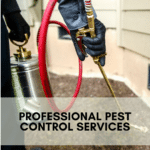

Need Help? Call Us On 0161 776 9832 For Expert Pest Control Advice On How To Identify Pest Infestations And Help Solve Your Pest Problem.
Carrington Wasp Nest Removal
The detection of a wasp nest on a property should not be taken lightly as the potential for serious harm to an inexperienced person trying to remove a nest is excellent. While wasps are generally not a threat to humans, any interaction which makes them feel threatened can lead to, at least, a painful sting and, in extreme circumstances, an allergic reaction that can lead to being treated in hospital.
to an inexperienced person trying to remove a nest is excellent. While wasps are generally not a threat to humans, any interaction which makes them feel threatened can lead to, at least, a painful sting and, in extreme circumstances, an allergic reaction that can lead to being treated in hospital.
Potential problem areas
The issue of Hornet and wasp control becomes apparent in the Spring each year as this is when the nests are starting to be constructed. Common locations where wasp and hornet nests are found are under trees and bushes, in the wall cavity or under the eaves of a building and in garden sheds and garages. Therefore, it is wise to keep waste bins fully covered during the warmer months and move them away from facilities. In the early stages of construction, the nest may be smaller than a snooker ball; however, as the colony grows, the nest may expand to be larger than a football.
The nest will contain one queen and between 3,000 and 5,000 'worker' wasps. The worker's lifespan is very short, being just 12-22 days, while the queen may live for more than a year. Hornets are rare in the UK, and the two main types of wasp are the common((Vespula vulgaris) and the German(Vespula Germanica).
Identifying
As previously stated, the Hornet is relatively rare in the UK and can be identified by its 'brown and yellow.'
 Stripes. Wasps have 'black and yellow lines. It should be noted that bees should not be confused with wasps as the bees provide an essential role in pollinating crops throughout the UK. In addition, bees are generally not aggressive towards humans if left alone.
Stripes. Wasps have 'black and yellow lines. It should be noted that bees should not be confused with wasps as the bees provide an essential role in pollinating crops throughout the UK. In addition, bees are generally not aggressive towards humans if left alone.
What to do when Wasps become a problem
When a wasp problem becomes apparent, it is best to employ the services of a professional wasp exterminator to get rid of wasp nests. When angry, a wasp can deploy a pheromone which will attract further wasps from the nest. It has been found that the earlier a nest is found and dealt with, the less aggressive the wasps are likely to be.
The wasp nest removal cost will be money well spent as it will remove a threat to humans, especially children, around the property. Carrington Wasp Nest Removal should be carried out by a professional wasp exterminator who will have the skills and equipment to get rid of wasp nests safely and efficiently.
How does hornet and Wasp control work?
The wasp exterminator will have access to a range of  insecticides and equipment, which will enable the safe and complete removal of problematic nests found close to human activity. The wasp nest removal cost will depend upon the location and size of the nest, along with the difficulty of completing the job.
insecticides and equipment, which will enable the safe and complete removal of problematic nests found close to human activity. The wasp nest removal cost will depend upon the location and size of the nest, along with the difficulty of completing the job.
The hornet and wasp control operative will place an insecticide around the area close to the entry point of the nest. As the wasps enter, they will carry the poison into the nest, leading to its destruction. When a nest has been abandoned, the wasps do not return to it next year.
How to stay safe from Wasps and Hornets
Fitting 'fly screens' to windows will ensure that insects of all types are kept out of a property when the windows are open during the warmer months. As mentioned earlier, maintaining waste bins securely closed and away from the property will help to reduce the chance of attractive potentially harmful pests. Checking the likely locations for a wasp nest during the Spring should allow for early detection and removal before the colony becomes established and more challenging to deal with.
The use of protective clothing, specialist insecticide  insecticides and the correct tools will lead to the safe removal of wasp nests. Professional assistance should be requested when dealing with any potentially dangerous pests found on a property.
insecticides and the correct tools will lead to the safe removal of wasp nests. Professional assistance should be requested when dealing with any potentially dangerous pests found on a property.
M31
